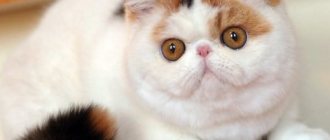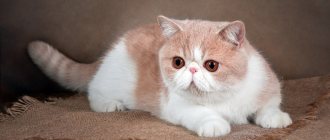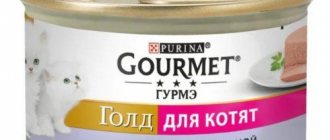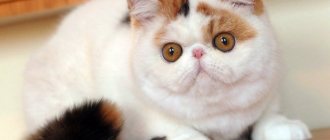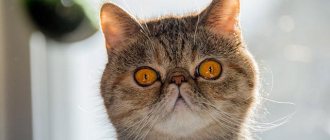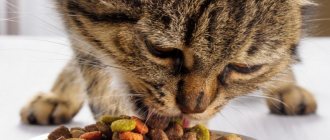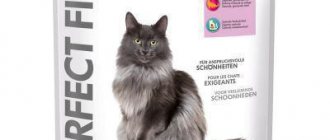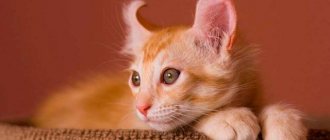Exotic Shorthairs are compact, attractive cats with plush fur, a flattened nose and huge, expressive eyes. Thanks to their charming appearance and friendly disposition, they are the object of dreams for adults and little animal lovers. But in order for communication with an exotic to bring only joy, before buying an exotic, you should study the main characteristics of the breed.
Brief history of the breed
The exotic shorthair cat, or exotic, appeared in the 50s of the last century. The main task of the breeders was not to develop a new variety, but to expand the color palette of the existing Persian cat breed. Therefore, we can assume that it arose completely by accident. To get other colors and make the American Shorthair's bones a little heavier, breeders decided to cross them with Persians. The kittens born from this mating were not at all similar to the original breed. The kids were almost an exact copy of their eastern ancestors. Although the Persians did not give them the luxurious long fur coat, they all had characteristic upturned noses and flattened muzzles.
In 1966, Jane Martink made a proposal to distinguish a new variety into an independent breed and call it “Exotic Shorthair”. This caused a wave of indignation among Persian breeders. But among them there were also those who showed interest in the new breed line of animals, and work on improving exotic animals continued. To fix the shorthair gene, breeders used Burmese and Russian blue cats. But as soon as the result was achieved, mating of exotics with anyone other than Persians was immediately prohibited.
Where to buy an exotic kitten, and at what price
Despite the fact that the breed is very popular, the sale of exotic kittens is not common in Russia. Those wishing to own this affectionate cat should contact nurseries in large cities - Moscow, St. Petersburg, Novosibirsk, Samara. Breeders in small towns are unlikely to find a purebred exotic.
On average, the cost of a kitten does not exceed $1,200. You can find a baby cheaper on the Internet, but there is no guarantee that they will sell you a purebred exotic cat. Thus, under the guise of a representative of a rare breed, unscrupulous breeders may offer cheap analogues - for example, a short-haired Persian cat.
Charming exotic kittens with constantly sad eyes can please anyone
Interesting Facts
During the existence of the exotic cat, many interesting things have been associated with this breed:
- Due to their short fur, which does not require special care, these animals are jokingly nicknamed “Persians for lazy people.”
- Thanks to their doll-like appearance and wonderful character, exotics often make it into the top ten most popular breeds.
- At first, they wanted to call snub-nosed cats “sterling,” which translated from English means “high-quality silver.” But after much thought and discussion, they began to be called exotic shorthairs.
- In addition to the exotics, there is another variety similar to the Persians - extreme. These cats have flattened noses that are noticeably pressed into the skull.
Price
The cost of an exotic cat depends on several components of its appearance:
- compliance with the breed standard;
- elite breed of parents (the more purebred the father and mother, the purer the blood of their offspring);
- color, rarity of the coat, fashion for a certain color at the time of purchase;
- routine vaccination carried out.
Private breeders always have lower prices than professional nurseries. Inexpensive exotics can be purchased on the market or online. Depending on the class, an exotic kitten can cost the buyer from 7,000 rubles. and more. The maximum price for the most purebred cat is about 50,000 rubles.
Breed description, standards, appearance
An exotic cat is a well-balanced animal with strong, somewhat heavy bones. The breed standard fully duplicates the requirements for Persians, with the exception of the clause on the length and structure of the coat.
Dimensions and weight
Representatives of the breed are not overly large in size. An adult exotic cat weighs up to 7 kg. The weight of a cat usually does not exceed 5 kg.
Anatomical characteristics
A typical Exotic Shorthair should fit the following description:
- The head is round, massive with a developed chin, full cheeks and wide strong jaws. The nose is short and upturned. The main feature of exotics is the stop placed strictly between the eyes.
- The ears are small, set wide apart, with rounded tips, slightly tilted forward.
- The eyes are expressive, convex, round. Located far from each other. The eye color is in harmony with the shade of the coat. Color-point exotics can only have blue irises.
- The body is without signs of obesity, squat, with developed muscles, massive shoulders and a broad chest.
- The limbs are short, thick, strong, with large rounded paws.
- The tail is carried below the level of the back, straight, without bends, and proportional to the length of the body.
Color and coat type
The body of the exotic is covered with a soft, silky, tight-fitting awn, the length of which does not exceed 2 cm. Under it there is a thick undercoat that can provide reliable protection from the cold.
The breed standard allows for the existence of many colors with the exception of light beige and cinnamon. The most common species are tortoiseshell, bicolor and tricolor. But solid colors of exotic cats, such as black or blue (gray), are considered rare.
On a note. White exotics can have different colored eyes. Heterochromia is also acceptable in individuals with Van, Harlequin and Bicolor colors.
Possible breed defects
Flaws in appearance, in the presence of which the exotic will not receive a high expert assessment:
- weak hind limbs;
- polydactyly;
- strabismus;
- asymmetry of the head or muzzle;
- creases on the tail;
- spinal deformity.
homemade food
When you decide to feed your furry friend natural products, you should focus primarily on the needs of the cat himself, but also not forget about the generally accepted rules:
The components listed above can be mixed together (except for dairy products) to prepare a warm dish for your pet. The maximum temperature of the finished dish cannot exceed 40℃, otherwise the animal may get burned.
No matter how hard the owner tries to please his pet, homemade food should be periodically supplemented with mineral and vitamin complexes prescribed by veterinarians.
Character and temperament
Representatives of the short-haired exotic cat breed are distinguished by their friendly, flexible and calm disposition. They feel the master’s mood very subtly and will never impose their company at the most inopportune moment. Exotic Shorthairs quickly become attached to people and need attention. These cats do not tolerate prolonged loneliness well. Due to their natural curiosity, they often lose their sense of danger. Therefore, exotic animals should not be left unattended for a long time.
The amiable nature of the exotic cat allows her to easily find a common language with children. She almost never shows aggression, and you have to try hard to unbalance her.
The exotic cat gets along without problems with his brothers and friendly dogs. But there may be problems with small rodents, ornamental birds and fish, since representatives of the short-haired exotic breed still have a hunting instinct.
How to choose the right kitten
Since this is a fairly popular cat breed, buying an exotic cat will not be difficult. The main thing is not to purchase an animal from someone else, but to look for a trusted breeder or a specialized nursery.
At the time of sale, exotic kittens must have documents confirming their breed and vaccinations. The first impression of an animal's character can be formed by observing how it behaves in its usual environment. And the health status of a potential pet is judged by its appearance. An exotic shorthair kitten should have clear eyes, clean ears, soft fur without bald spots and smooth skin without scratching or rashes.
On a note. A kitten's bloated belly may indicate a helminthic infestation. And dirt under the tail and stench from the mouth are signs of digestive problems.
Kitten care
Responsible breeders wean exotic shorthair kittens from their mothers and hand them over to new owners no earlier than they are 3 months old. By this age, the animal already has the necessary vaccinations, eats independently, goes to the tray and knows how to use a scratching post. The owner just has to show the kitten where he can eat, recover and sharpen his claws.
In order for adaptation to changed conditions to happen faster and without problems, the exotic is given time to get acquainted with his new possessions. He is petted more often and involved in various games.
To prevent a curious exotic kitten from becoming a victim of an accident, houseplants, household chemicals, wires, small and fragile objects are removed from it. Also, for safety reasons, close the doors of ovens, washing machines and dryers.
What not to feed
Although many owners experiment with their exotic four-legged friends and allow them to eat “their” foods, veterinarians point out a number of food products that can significantly harm the cat’s health:
- Milk. If small kittens are still allowed to be given low-fat pasteurized milk in small quantities, then this product is not at all suitable for feeding adult exotic cats. It often causes bloating and digestive disorders.
- Sour milk with a high percentage of fat content.
- Salt and various spices.
- Potatoes, because they are completely indigestible.
- Pork.
- Sweets.
- Legumes (soybeans, beans, peas). Causes severe bloating, flatulence and fermentation.
- Floury.
- Sausages.
- Chocolate is one of the most dangerous foods for an exotic shorthair. This product contains theobromine, which can cause poisoning and sometimes death.
Care and maintenance
Exotic shorthairs adapt well to different conditions. Cats of this breed live without problems in both small apartments and spacious country houses. The main thing is that they have their own corner to relax. It is better to arrange it closer to the owners so that the exotics feel protected.
Hygiene procedures
In order for the cat to look neat, he is provided with complete care:
- Exotic ears are cleaned weekly of accumulated dust and dirt. To do this, a special agent is instilled into each of them. After a few minutes, the exotic’s ears are carefully wiped with a cotton pad or clean cloth.
- The cat's eyes are examined daily for unusual discharge. If necessary, wipe them gently with a moistened cotton pad.
- The exotic shorthair's teeth are cleaned 2-3 times a month with a non-foaming paste and a silicone brush or a special attachment. This simple procedure will prevent the formation of plaque and stone.
- Exotic claws are shortened with a nail clipper as necessary. This is done very carefully so as not to injure living tissues and not cause pain to the cat.
Grooming
Exotics are short-haired animals that do not require such professional coat care as their closest relative, the Persian cat. To make them look attractive, it is enough to comb their fur twice a week with a special metal comb.
On a note. The smooth-haired exotic is a very clean cat. He often licks his thick coat, clogging his digestive tract with lint. Therefore, it is recommended to periodically give him special pastes that dissolve wool.
Exotics are bathed no more than 3-4 times a year. Bath procedures are carried out in a warm room, away from drafts. The exotic shorthair is lathered with a special shampoo and thoroughly rinsed with clean water. The bathed cat is dried with a towel and, if necessary, dried with a hairdryer.
Tray
The Exotic Shorthair is a rather large cat. Therefore, the tray for her is chosen to be quite spacious and deep. It is installed in a secluded corner, where no one will disturb the exotic creature’s privacy. The filler can be anything - wood, silicate, etc. The main thing is that it is of high quality and that the cat likes it.
Features of shorthaired exotics
Short-haired representatives of the breed were obtained in the 60s of the 19th century.
As a result of crossing, a Persian and an American shorthair produced a cat very similar to the British cat. The structure and body structure of the British and exotic cats are very similar. But the character is different. The British are less active in games and are not as affectionate in temperament. The nose of the exotic is flattened. Short-haired cats require minimal care. They are very clean and can handle cleaning their undercoat on their own. In some cases, owners only need to massage the fur coat occasionally, about once every two weeks, with a special comb. This is necessary not only to give a gloss to the surface, but also serves as an excellent massage, helping to improve the animal’s blood circulation.
Short-haired cats are very pleasant to the touch. Although their coat is not fluffy, it is very bright and soft. Accordingly, there will not be much fur from such pets in the house, although during the molting period they also shed all excess.
Feeding the cat
In order for the exotic to grow well and develop properly, it is provided with a balanced diet.
Complete diet
Exotic shorthairs are unpretentious animals with an excellent appetite. They eat both industrial and natural food with equal pleasure. At home, it is easier and easier to feed a cat of this breed with premium or super premium class dry food, which already contains all the necessary substances. These requirements are best met by the British Arden Grange, the American Pro Pac, the Italian Monge and the German Bosch.
With a natural type of nutrition, the diet of an exotic shorthair is designed so that it contains at least 70-80% meat. The cat is also given:
- boiled eggs;
- porridge with water;
- offal;
- boiled vegetables;
- dairy products;
- lean sea fish.
An exotic shorthair cat should not be given pork, onions, potatoes, whole milk, sweets, sausage, baked goods or smoked foods. Representatives of the breed are prohibited from feeding pickles, river fish and any leftovers from the master's table.
Feeding frequency
An exotic kitten eats less, but more often than an adult representative of the breed. Therefore, the number of feedings depends solely on the age of the animal:
- up to 12 weeks – 5-6 times a day;
- 4-7 months – 4 times a day;
- 8-11 months – 3 times a day.
From the age of one year, the exotic shorthair cat is fed twice a day.
Vitamins and minerals
When feeding natural products, not all necessary substances enter the body of an exotic shorthair. To compensate for the deficiency of vitamins and microelements, the cat is given special supplements in courses twice a year. Feeding should be selected by a veterinarian, taking into account the individual characteristics of a particular animal.
Health
Let's look at what health problems are most typical for exotics.
Let's start with a question that is typical not only for exotic cats, but also for other breeds. This is castration or sterilization. Not everyone knows how to properly care for a cat after castration, and this is a very important point regarding its future health.
At this age, he has already managed to get stronger, but the reproductive and reproductive systems are not yet fully formed. In the first days after surgery, the exotic patient must be provided with complete rest. He may need painkillers at first. Immediately after surgery, cats typically experience dry eyes. The fact is that the operation is performed under anesthesia, but during anesthesia the eyes do not close, so they dry out. You can gently pat your eyes with a damp cloth to help them recover faster, or use eye drops.
Exotics often have sinus problems. Difficulty breathing or other defects are usually associated with the structural features of their flattened nose.
The need for brushing teeth and preventing exotic oral diseases was discussed above. The most common disease affecting their teeth is the formation of tartar.
Sometimes there are diseases associated with cardiovascular diseases. In this case, it is necessary to make fundamental changes to the animal’s diet.
For all cats, the problem with the kidneys also remains relevant. In principle, this disease is also associated with dietary patterns. If you feed your cat a healthy and varied diet, the problem can be avoided.
In any case, if you suspect your cat is not feeling well, you should absolutely not do home treatment, but should first show your pet to a specialist. The veterinarian will carefully examine the cat, take the necessary tests if necessary, prescribe medications and give recommendations on the diet and maintenance of the pet. In general, exotics have good health and good immunity.
Bottom line
So, exotic cats have deservedly conquered the world and the Internet thanks to their cute appearance and extremely friendly character. This is an ideal pet that does not require careful care, is not picky about food and can be trained quickly. You won’t get bored with him, because exotics really love active games with their owners, they treat children well. As a rule, they are very attached and devoted to one person, and will certainly never forget him. The presence of such a cat adds comfort to every home.
For more information on caring for and maintaining exotics at home, see below.
Education and physical activity
Exotic Shorthairs are intelligent cats that are receptive to training. They easily get accustomed to the tray and scratching post and easily learn basic commands. In the process of raising an exotic, force and threats should not be used. If a cat is intimidated and physically punished, there is a risk of losing its trust forever.
Exotic shorthairs have a fairly active temperament. Active and playful cats will not refuse to run after a ball or a laser pointer. And so that exotics don’t get bored when their owners are away, you can buy them several toys and arrange a corner with multi-level shelves.
Vaccinations and antiparasitic treatment
To prevent possible infection with infectious and viral diseases, exotic shorthairs are regularly vaccinated. The complex drug stimulates the production of immunity:
- to calcivirus;
- rhinotracheitis;
- panleukopenia.
The first vaccination for an exotic shorthair is given at the age of 7-8 weeks. After 4 weeks, the cat is vaccinated against the same diseases and against rabies. Subsequently, the exotic is vaccinated annually.
To protect a cat of this breed from diseases carried by fleas and worms, it is periodically subjected to antiparasitic treatment. Anthelmintic drugs for exotic shorthairs are given 2 times a year with mandatory repetition after 10-14 days.
A cat of this breed is protected from fleas using special drops and shampoos. And if an exotic shorthair is outdoors, an anti-parasitic collar is additionally put on it.
Pros and cons of the breed
Like any other breed of cat, Exotic Shorthairs have both advantages and disadvantages.
| pros | Minuses |
| Beautiful exterior | Discharge from nose and eyes |
| Easy to care for | Predisposition to certain diseases |
| Peaceful disposition |
The Exotic Shorthair is an attractive cat that looks like a plush toy. Her unusual appearance combined with her gentle nature and moderately active temperament make her an ideal companion for families with children and single people who spend a lot of time at home.
